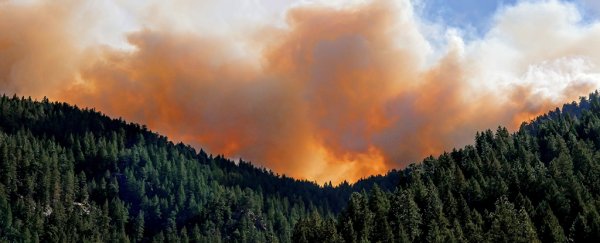Plants and trees choose where to put down their roots based on the surrounding environment, and as the world's climate shifts, trees and other vegetation are on the move: movements which are accelerated by the spread of wildfires, according to a new study.
Both tree and animal species alike are expected to head towards cooler and wetter locations as the world warms up, in order to find habitats more suitable for growth and reproduction.
For plants creeping their way steadily into higher elevations, this migration isn't exactly slow going, averaging a pace of around 1.5 meters (or around 5 feet) a year.
If wildfires are helping some species get ahead of others, that's an important consideration for forest management and preservation – especially as the factors driving this tree wandering aren't fully understood by scientists at the moment.
"Complex, interdependent forces are shaping the future of our forests," says plant biologist Avery Hill from Stanford University in California.
"We leveraged an immense amount of ecological data in the hopes of contributing to a growing body of work aimed at managing these ecosystem transitions."
Researchers analyzed a total of 74,069 forest plots across nine states in the western United States, looking at the distances between mature trees and new seedlings to estimate how quickly tree species were migrating from one place to another.
Of eight species that appeared to be on the move, two – the Douglas fir (Pseudotsuga menziesii) and the canyon live oak (Quercus chrysolepis) – showed signs of bigger shifts in areas affected by wildfire compared with areas that hadn't been burned in recent years.
While this particular study doesn't look in detail at the reasons for this happening, the researchers suggest the ability for species such as the canyon live oak to sprout quickly after a fire gives it an advantage. Coupled with the destruction of the canopy, a wildfire could benefit some migrating plant species over others.
That's probably not the whole story here, however.
"Wildfire, because it reduces vegetation cover and therefore reduces some aspects of plant-plant competition, provides an entry point for exploring the hypothesis that removing competitors can accelerate climate-related range expansion," the researchers write in their paper.
"Of course, the effects of fire on community assembly certainly go beyond reducing plant-plant competition, and other aspects of fire ecology could influence climate-related range shifts."
There is evidence that certain trees aren't able to keep pace with climate change – potentially leaving some species stranded in habitats that aren't suitable, because they're unable to move to newer areas fast enough.
That's where measures such as controlled burning could come in. Low-intensity, small-scale fires can be artificially created to limit wildfires and manage forests, and they may have a role to play in responding to climate change as well.
As the researchers say, though, the evidence right now is incomplete. Different tree species will react in different ways, and the impacts of wildfires go way beyond tree migration – so further studies going into more detail will be required.
"This study highlights a natural mechanism that can help forests remain healthy, even in the face of small amounts of climate change," says biologist Chris Field from Stanford University.
"It also illustrates the way that ecosystem processes often have several layers of controls, a feature that emphasizes the value of detailed understanding for effective management."
The research has been published in Nature Communications.
